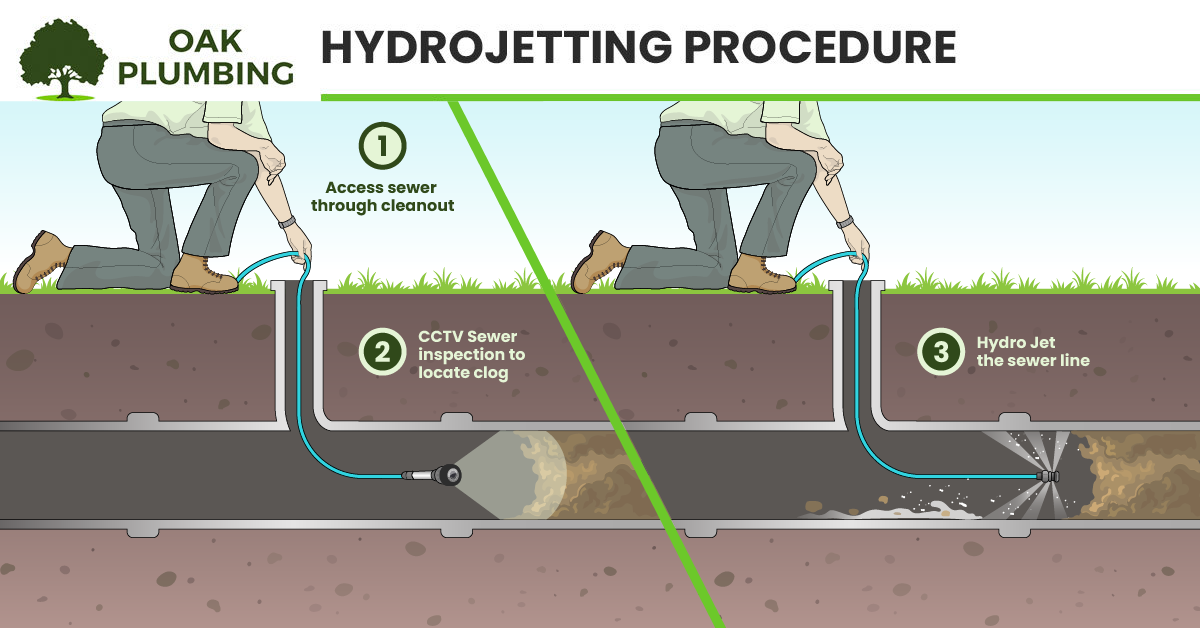Hydro jetting a sewer line is the most effective way to get rid of stubborn blockages. By the end of this short article, you'll know what hydro jetting is, how hydro jetting is done, the pros and cons of hydro jet drain cleaning, and more.
What Is Hydro Jetting a Sewer Line?
Hydro jetting involves using nothing but pressurized water - up to 4000 PSI - to clear a sewer line of stubborn blockages, including small tree roots. Hydro jetting is often used after other methods - like snaking - fail to achieve lasting results.

Hydro Jetting vs. Snaking a Sewer Line
Hydro jetting involves using highly pressurized water to clean a sewer line, while snaking pushes a long steel cable into the sewer line to remove obstructions.
Hydro jetting a sewer line
Hydro jetting a sewer line involves using nothing but pressurized water to clear away blockages. It's a highly effective and fast technique for cutting through stubborn clogs that can't be cleared via snaking.
Hydro jetting just doesn't get rid of clogs; it also thoroughly cleans the pipe's walls. After hydro jetting, the inside of the pipe is basically like new. There's no residue left behind, and the pipe's walls are smooth. Hydro jetting a sewer line is much more effective than snaking, which just pokes holes in the clog.
Hydro jetting a sewer line is not a DIY project
Hydro jetting is not a DIY project. Before using highly pressurized water on a sewer line, the hydro jetting technician must conduct a CCTV sewer inspection. This involves inserting a special camera on wheels into the pipe to see what's creating the blockage. If a collapsed pipe is causing the blockage, hydro jetting isn't the solution. The pipe will need to be replaced.
A CCTV sewer pipe inspection also looks at the pipe's condition to ensure it's suitable for hydro jetting. This visual inspection beforehand is essential because pressurized water can damage an old, fragile sewer pipe.
Hydro jetting also uses various nozzles, depending on what's blocking the pipe. A trained hydro jetting technician will know which nozzles to use and when.
Snaking a sewer line
Snaking a sewer line involves pushing a long steel cable through a pipe to clear obstructions. The problem with sewer snaking is that while it can break through clogs and cut away small roots, it can't get rid of everything in the pipe. Unlike hydro jetting, sewer snaking can't get rid of roots entirely and can't clean the pipe's walls.
While both tools are good, hydro jetting does a more thorough job, which is why it's more expensive than snaking.

What is the Hydro Jetting Procedure?
The general hydro jetting procedure is as follows:
1. The sewer line is accessed via removing the cap on the cleanout.
2. The hydro jetting technician inserts a small CCTV sewer camera into the pipe via the cleanout, looking to see the pipe's condition and what's causing the blockage. A collapsed or broken pipe needs a solution other than hydro jetting. The CCTV inspection is also necessary to see if the pipe is strong enough to withstand the highly pressurized water.
3. After the hydro jetting technician determines that hydro jetting is the appropriate solution, the hydro jetting nozzle/hose - which is connected to a tank of water and a machine creating the pressure - is inserted into the cleanout and moved down the sewer line, spraying the pressurized water and getting rid of everything in its path. The type of nozzle used will depend on what's clogging the pipe.
How long it takes to clear the blockage depends on the type of blockage and the blockage's location. The amount of pressure used depends on the type of blockage and the pipe's condition.
As mentioned above, hydro jetting a sewer line is not a DIY project. It requires special equipment - including a CCTV camera - and training. Never allow someone without experience to hydro jet your sewer line.

Hydro Jetting: The Pros and Cons
Pros
- It gets rid of everything instead of just poking holes in the blockage. The pipe's walls are washed clean.
- It's non-invasive. No digging is required to access the pipe. Access is gained through the cleanout.
- It's safe and environmentally friendly because it's just pressurized water, nothing else.
- It's able to break up and wash away small tree roots.
Cons
- 4000PSI can damage older, fragile pipes. This is why the technician must look inside the sewer pipe first.
- You can't do this yourself. Hydro jetting requires special equipment, training, and experience. If you break a fragile pipe, it will need to be replaced.
- When You Might Need To Hydro Jet Your Sewer Line
You might need to hydro jet your sewer line if:
- You've tried everything else, but the clogs are stubborn and continue to reoccur.
- You're interested in preventative maintenance. Regularly hydro jetting your sewer line is a way to ensure it stays clean and free of blockages.
- You have a problem with small tree roots in your sewer line. Hydro jetting is an easy way to eliminate them before they grow big enough to break the pipe. If that happens, the sewer line will need to be replaced, which is expensive.
- You own a restaurant and throw a lot of grease down the drain.
If you think your sewer line could benefit from hydro jetting and you're in our service area in Benicia, CA, contact us today!

